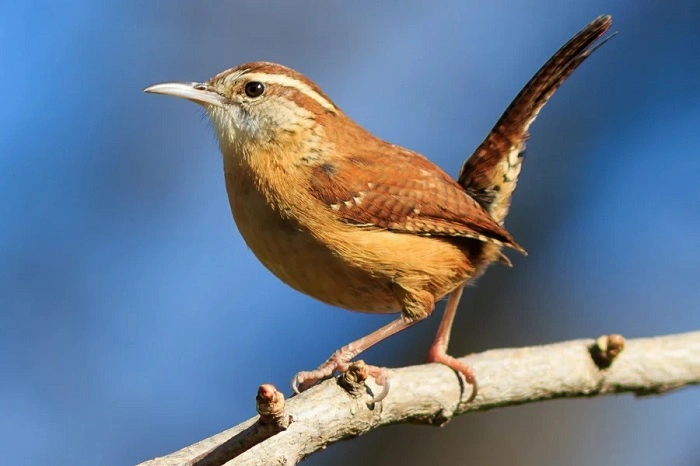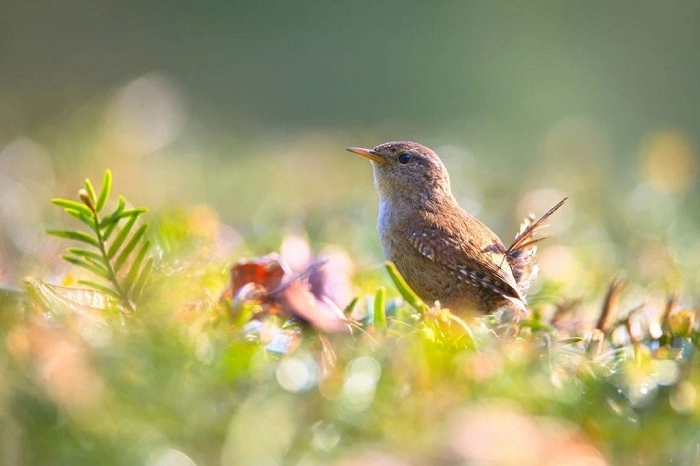What is a Wren Bird?
The wren bird is one of the most charming and energetic songbirds found across many parts of the world. Despite its small size, the wren bird is known for its powerful and complex singing voice. Wrens belong to the family Troglodytidae and include over 80 species, most of which are native to the Americas. In Europe, the Eurasian wren (Troglodytes troglodytes) is the most common representative.
Wrens are often recognized by their upright tails, brown or grayish plumage, and quick, hopping movements. These birds may be tiny, but their lively presence and remarkable singing capabilities make them beloved in both urban and rural environments.
Physical Features of the Wren
Small But Strong
Wren birds typically measure between 3.5 to 5 inches (9 to 13 cm) in length and weigh only around 8 to 12 grams. Their size makes them vulnerable to predators, but their agility and secretive behavior help them survive in dense shrubs and undergrowth.
Recognizable Tail Position
One of the most iconic features of a wren is its tail, which often sticks up vertically. This posture, combined with their small round body and quick movements, makes them easily distinguishable.
Color and Markings
Wrens are mostly brown, with subtle streaks or speckles. Their coloring helps them blend perfectly with dry leaves and bushes, which offers both camouflage and comfort in their natural habitat.
Wren Bird Habitat and Distribution
Global Presence
Wrens are primarily found in North and South America, though the Eurasian wren stretches across Europe and parts of Asia. In North America, common species include the House Wren, Carolina Wren, and Cactus Wren.
Preferred Environment
These birds are adaptable and can live in forests, gardens, deserts, and even near human dwellings. However, they generally prefer thick vegetation, shrubs, or wooded areas where they can build nests and forage in safety.
Behavior and Diet
Active and Curious
Wrens are known for their restless nature. They are always hopping, bobbing their tails, and exploring their surroundings. This active lifestyle is necessary for survival as they search for food and protect their territories.
What Do Wrens Eat?
Wrens are insectivores. Their primary diet consists of spiders, caterpillars, beetles, and other small insects. Occasionally, they also eat berries and seeds, especially in colder months when insects are scarce.
Singing and Communication
Perhaps the most endearing trait of the wren bird is its loud and melodious song. Despite their size, male wrens sing complex tunes to defend territory and attract mates. Their songs can often be heard echoing across fields, backyards, or forests in the early morning.
Nesting Habits of Wren Birds
Nest Building
Male wrens are the primary nest builders. They construct several dome-shaped nests out of twigs, leaves, and grass. The female then selects one and lines it with softer materials before laying eggs.
Eggs and Incubation
A typical clutch includes 5–8 small, white eggs with reddish speckles. The female incubates the eggs for about 12–15 days while the male guards the territory.
Raising the Young
Once hatched, the chicks are fed by both parents. The young birds leave the nest after about two weeks but may continue to be fed for several more days as they learn to forage on their own.
Types of Wren Birds
House Wren
Common across North America, the House Wren is known for adapting to suburban environments. It often nests in birdhouses and sheds.
Carolina Wren
Found mainly in the southeastern U.S., the Carolina Wren is slightly larger and has a loud, ringing song that is often heard before the bird is seen.
Eurasian Wren
This species is found throughout Europe and parts of Asia. Despite the cold winters in many regions, Eurasian wrens are year-round residents and survive with clever sheltering techniques.
Cactus Wren
The largest wren species in the U.S., the Cactus Wren resides in desert areas like Arizona and New Mexico. It nests in thorny plants like cacti for protection.
Wren Bird in Culture and Symbolism
Symbol of Joy and Energy
The wren has long been admired for its musical talents and energetic behavior. In Celtic mythology, the wren represents wisdom, divinity, and joy. Its small size but strong voice symbolizes courage and resilience.
Featured in Literature and Poetry
Many poets and writers have drawn inspiration from the wren’s sweet song and vivid presence. Its connection with the natural world and themes of renewal make it a common subject in classic and modern nature writing.
How to Attract Wrens to Your Backyard
If you’re a birdwatcher or nature lover, attracting wrens can be both easy and rewarding
Use small nest boxes or birdhouses with entrance holes no wider than 1 inch to keep out larger birds
Keep the area well-vegetated with native plants and shrubs
Avoid pesticides so that wrens can find enough insects to feed on
Provide clean water in bird baths or shallow dishes
Offer occasional mealworms during spring to support busy parents during nesting season
Wren Conservation Status
Most wren species are currently not threatened, but their populations can be affected by habitat loss, climate change, and predation by domestic cats. Ensuring native shrubs and safe nesting spaces can help sustain healthy populations in your local area.
FAQs About Wren Birds
What does a wren bird eat?
Wrens mainly eat insects such as beetles, caterpillars, and spiders, but they also enjoy seeds and berries.
Where do wren birds live?
They prefer shrubs, woodlands, and gardens with dense vegetation. Some species are even found in deserts and urban areas.
Do wren birds migrate?
Some species like the House Wren migrate seasonally, while others, like the Carolina Wren, remain in their range all year.
Are wrens good for gardens?
Yes, wrens help control pests naturally by feeding on insects and spiders in your garden.
What makes the wren’s song unique?
Despite their tiny size, wrens produce powerful, complex, and melodic songs used to attract mates and mark territory.
Final Thoughts
The wren bird is a true example of how size doesn’t define strength or beauty. With its vibrant personality, high-energy behavior, and enchanting songs, the wren adds life and melody to every habitat it occupies. Whether you encounter one in a garden, forest, or open field, this little bird is sure to leave a big impression.
If you’re lucky enough to hear a wren sing or see it hopping through your shrubs, take a moment to appreciate one of nature’s most remarkable small wonders.




